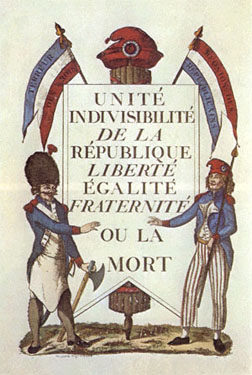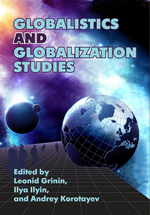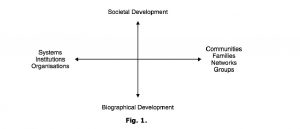Is Another World Really Possible? The Slogans Of The French Revolution Reconsidered
 The famous slogan of the French Revolution was “liberty, equality, fraternity“. In the succeeding two centuries the world has demonstrated both the contradictions of this slogan and the very limited degree to which in fact any of its three elements have been realized anywhere in the modern world-system.
The famous slogan of the French Revolution was “liberty, equality, fraternity“. In the succeeding two centuries the world has demonstrated both the contradictions of this slogan and the very limited degree to which in fact any of its three elements have been realized anywhere in the modern world-system.
Today, the question is whether, in a future world-system, there are ways of making this trio more compatible each with the other. We are dealing here not with this trinity but rather with the relation between inequality, pluralism, and the environment. It is hard to say what the French revolutionaries would make of this discussion. Pluralism was exactly the opposite of their aspirations, since they wished to eliminate all intermediaries between the individual and the state of all the citizens. The environment was entirely outside their topic. And inequality was assumed to be inevitable on tis way out, precisely because of their victorious revolution.
“But these questions about both trinities are very much unresolved today. The next several decades will be a period of collective world decision about precisely these issues, about whether another world is really possible in a foreseeable future. I shall start by discussing the least discussed, indeed the long almost-forgotten, member of the French Revolution’s trinity, fraternity. It is only in recent decades that fraternity has returned to the forefront of our collective concerns, but it has indeed returned, and with a vengeance”.
Fraternity
What do we mean by fraternity? To be sure, the first problem with any definition or elaboration of the concept – one that is now obvious to us, but was not at the time of the French Revolution nor throughout the next century and a half at least – is the term itself. It is a masculine term, and thereby leaves out more than half the world’s population. The French revolutionaries had in fact a terrible record on the question of the rights of women. On July 20, 1789, less than a week after the storming of the Bastille, Abbé Siéyès, in a report to the National Assembly, placed women, along with children and foreigners, in the category of passive, as opposed to active, citizens. He said of the distinction:
“Everyone is entitled to enjoy the advantages of society, but only those who contribute to the public establishment are true stockholders (actionnaires) of the great social enterprise. They alone are truly active citizens, true members of the association” (Siéyès, 1789, 193-194).
On Dec. 22, 1789, the National Assembly formally excluded women from the right to vote. And when in 1793, the Society of Republican-Revolutionary Women was formed and began to agitate for the rights of women, the Committee on Public Safety appointed a committee to consider whether women should exercise political rights and whether they should be allowed to take part in political clubs. The answer to both would be no. The committee deemed that women did not have “the moral and physical qualities” to exercise political rights (George, 1976-77, 434).
But sexism was only one of the constraints on the concept of fraternity. Although fraternity was put forward as a bedrock of universal values, it was almost never meant to be global in application. It was the fraternity of all those who were citizens of a given country. Nor was such nationalism the characteristic merely of middle-class political movements and those with bourgeois values. Throughout the nineteenth and twentieth centuries, nationalist sentiments constantly overcame the professed universalism of labor and Marxist movements as well. Workers of the world may have been adjured to unite, but as we know all the important worker and socialist parties that would emerge in this period were national in scope and, when push came to shove, national in objective.
We hardly need add that fraternity was almost never in reality trans-racial. The perceived and constructed divide between the White world and the non-White others seemed virtually self-evident for a very long time. And when, in recent decades, it has been challenged more vigorously and effectively by non-White movements, it has re-emerged in slightly more masked form, as the divide between cultures or as the meritocratic divide. The verbiage has changed, but the results remain roughly the same.
Equality
And what is equality? It obviously means sameness or at least similarity in something – but in what? Therein lies a not so subtle terminological minefield. For some it means equal life chances – the absence of socially-constructed barriers to a certain standard of living or of other measures of economic equality. But for others, it means not equality of life chances but equality of life results. And to still others, like Marx in the famous quotation, it means “to each according to his needs“, a concept that recognizes that people are unequally endowed (although what exactly does that mean?), therefore have different level of “needs,” and should consequently be accorded not identical portions but the portion that each person “needs.”
Equality has also been interpreted in a quite different way as meaning meritocracy – each gets what he/she merits. This is a variant of equality of life chances. Each of us is said to start off from a mythical identical point and arrive where his work and/or intelligence gets him. But of course we do not start off from identical points. Attempts to compensate for that by social decree is what we mean by “affirmative action“, which in turn is criticized as being “reverse racism” as well as a program that undermines the meritocratic principle. In the United States, authorities bend over backwards to deny that affirmative action means quotas, and have insisted that the object of all arrangements should be individual equality. They are therein giving verbal endorsement of the position of the French revolutionaries rather than adhering to any concept of pluralism. Other countries are less reticent about recognizing group rights and imposing outright quotas in consequence. Switzerland has long had linguistic quotas in its civil service. India is currently debating whether, in addition to the reservation in state universities of 22.5% of the places for “scheduled” castes and tribes which is what they currently attribute, they should reserve another 27% for “other backward castes,” a social category that is higher than that of “scheduled” castes and tribes but lower than that of half the population.
Equality has been promoted in the political sphere as well. One simple meaning is that all citizens have the same rights – thus abolishing any distinction, such as that between aristocracy and commoners, the more educated and the less educated, or that of Siéyès between active and passive citizens. These rights can have to do with elections (voting, standing for office), with the judiciary (equality before the law), or property (right to own, right to inherit). But of course an opposite road to political equality is to deny any right to distinctiveness whatsoever. The recent debate in France concerning the rights of Muslim girls to dress in headscarves (foulards) was resolved by legislation outlawing wearing of any “obvious” (ostensible) religious symbols by persons adhering to any religious faith. This was meant to be an imposed equality, and others objected to it precisely on the grounds that it violated the individual’s or group’s right to religious freedom as reflected in the right to particular symbolic items to place upon the body.
Concept of liberty
If equality is ambiguous in the simple sense that there is wide disagreement about what is to be equalized, there is even more ambiguity about the concept of liberty. What is liberty? Endless authors have written on the subject. And it has been a matter of no small public debate and concern, as well of course of rhetorical flourish. There is the famous question of where is the line between an individual’s right to do as he/she deems fit and his/her infringement thereby on the right of someone else to do as he/she deems fit. And then there is the equally famous question of the line between an individual’s right to do as he/she deems fit and the right of the collectivity of which he is a member (but what does it mean to be a member of a collectivity?) to protect the group’s interest and perhaps indeed survival as a group, which conceivably could require limiting or annulling the right of the individual to do as he/she deems fit.
Today, we are in the curious situation that virtually everyone – from the far right to the far left – asserts they are in favor of, indeed defend, freedom. But of course, the practical meanings which they give to this assertion are not merely radically different but often totally opposite one from the other. So, the defense of liberty or freedom has become a rhetorical device, a claim of virtue that has rather little purchase.
It is of course not only that these three elements of the slogan are embroiled in terminological debate and confusion, but the relation of one part of the slogan to the other has an equally unclear history. The most famous debate is about the relationship of liberty and equality. Many, perhaps most, analysts and publicists have tended to make the case that one must choose between the two objectives, at least in terms of priority.
The extreme arguments of these views illustrate the profundity of the chasm. There are those upholders of the priority of liberty who have argued that the search for equality actually imperils the realization of liberty. They often argue that to achieve equality, there must be social imposition of equalizing – that is, actions by the state to redraw material and other allocations. This, they say, necessarily leads to a totalitarian state, which is defined as a state that leaves no room whatsoever for liberty.
There are, however on the other hand, those upholders of the priority of equality who have argued that the search for liberty leads to establishing formal rules that imperil, indeed contradict, any expectations of achieving equality. Anatole France summed up the basis for this position well in his well-known quip: “The law, in its majestic equality, forbids the rich as well as the poor to beg in the streets, steal bread, or sleep under a bridge.”
As for fraternity, insofar as it endorses group sentiment and thereby tends to place one’s own group over other groups, it seems to contradict the idea of equality. And insofar as it endorses the defense of the group rather than of the individual, it seems to contradict the idea of liberty that each can do what he/she deems fit.
By the twenty-first century, we have become somewhat jaded about the merits of the slogan of the French Revolution. Few invoke it. Even fewer believe it has been realized or could indeed be realized anywhere. And yet too many assert that it has been better realized in one’s own country than in other countries, thereby transforming the struggle for such values into a nationalist boast or, even worse, an excuse for war.
World Social Forum
Still the underlying idea of the slogan, that one could construct a world in which such values were held high, remains an inspiration for all those who refuse to accept the inevitability of the manifest injustices of the world in which we live and of the previous world-systems in which our ancestors lived. Those who have come together in the World Social Forum proclaim their objectives in a slogan that has caught on: “Another world is possible.” So we come to the legitimate question today, is another world really possible? And if so, what should such a world look like, and how could we arrive nearer to its creation? I shall try to answer by delineating what is at issue in the three themes we have set ourselves: pluralism, environment, and inequality.
To advocate pluralism is to raise a basic question about the historical construction of the modern state-system. In the international law that we have constructed, the states were said to be sovereign. We have meant by that idea two things. Externally, it is the argument that each state can decide by itself, and by itself alone, what shall be the governing laws and policies of that state. It is a refusal of the right of others outside the state to interfere with this process. And internally, it means that no institution within the boundaries of the state can reject the legitimate decisions of the central authority which is supreme.
Sovereignty is a unifying and homogenizing idea. The French Revolution did not launch the concept but it illuminated its implications. Since the French revolutionaries were creating what they and others at the time considered to be a different kind of state, based on different principles, they were asserting that no other state could use force or influence to make them desist. They were not responsible, as we know, for launching the European wars that started in 1792 and in which France was embroiled for two decades thereafter. But, as we also know, the French thereupon violated the very idea of sovereignty that they were defending by proclaiming the right to combat tyranny everywhere and to spread by military invasion the presumably universal values of the French Revolution.
The external version of sovereignty has always been a fiction. Stronger states have constantly interfered with the internal processes of weaker states. They have done so by invoking so-called universal values that they said permitted them to fight barbarism, and by insisting on the superiority of their own cultures and technologies. These asserted cultural differences served as the justifications of the inequalities resulting from the practices of power. But, if the weaker states tried to adopt the values of the stronger states in order to remove this justification, they were told they had to do this on bases that ensured the openness of their frontiers to unequal divisions of labor and other mechanisms that maintained, indeed magnified, the inequalities (see Wallerstein 2006).
National Assembly
As an internal doctrine, the French revolutionaries interpreted sovereignty to mean Jacobinism – that is, the right to impose uniformity throughout the realm: unifying the judicial system, abolishing all intermediary bodies, making French the only legitimate language, creating a single system of weights and measures, creating the secular state. In 1792, the Marquis de Clermont-Tonnerre said in the National Assembly: “The Jews must be refused everything as a separate nation, and be granted everything as individuals” (Davies, 1996, 73). Although the Jacobin version in France is considered the extreme exemplar of this position, the internal homogenizing concept of sovereignty was tacitly or even explicitly adopted by almost all states in the modern world-system in the nineteenth and twentieth centuries.
It is only in the past 30-40 years that serious pmolitical challenges to this concept of national uniformity have been made. The basic objection of these challenges has been that all “minorities” were in effect told that they had only one choice: if they wished to become citizens in some full sense, they had to “assimilate” – that is, to adopt as closely as possible the social and cultural traits of the dominant group within the state. Failing this, they could legitimately be excluded, formally or informally, from the rights of citizens. In many cases, this “dominant” group indeed constituted a majority of the population – hence, the reason that we speak of the others as “minorities.” But there are not a few cases in which the “minorities” were actually the majority of the population.
This “dominant” group might be defined racially, ethnically, linguistically, by religion, or any combination thereof. But it was always obvious to everyone who they were and how they were defined, even if the definition in a particular place evolved over time. The dominant group was of course dominant not only in this cultural sense but politically, economically, and socially as well. Defending itself against criticism, the dominant group has tended to argue that cultural integration was the entrance key that would open the way for “minorities” to achieve political, economic, and social equalization. But in fact the opposite was most often true. Cultural integration did not lead to these equalizations. The unequal realities somehow managed in large part to continue (if less obviously), but the ideology of cultural integration did deprive the group that was being “integrated” from the collective political strength they might have used to struggle for more equalization. So-called assimilation has been on the whole an extremely effective means of preserving inequalities within the state.
The concept of pluralism was a response to the worldwide and national pressures to homogenization, which the groups that were weaker or were “minorities” believed had ensured the continuation of the inequalities from which they suffered. Pluralism meant recognizing the existential reality of multiple groups within the state and therefore the rights of such “groups” both within the world-system and within each state. These groups might be so-called indigenous peoples; they might be racial, ethnic, linguistic, or religious groups different from the “dominant” group in the world-system or within each state. Pluralism was a demand both for collective group rights and for recognition of and compensation for the past maltreatment that constituted a structural base for present-day inequalities.
Revolution of 1968
The historic turning-point in the demand for pluralism was the world revolution of 1968. This world revolution was in part fired by the awakening and/or deepening of pluralist demands in the post-1945 period and in part by the effective elaboration of pluralist doctrines against the previously dominant centrist liberal ideology which had always refused to recognize the legitimacy of pluralism. It is not that pluralism triumphed in 1968, but rather that it gained droit de cité. It is not that assimilation died as a doctrine but that it lost its status as a self-evident proposition. An open struggle had now begun, and of course is still going on.
The story of environmental concerns is not very different. The maltreatment of the environment within the modern world-system is not at all something new. It has been going on throughout its history. But it was facilitated by a very simplistic idea of property rights. It was said that each of us, but most particularly each entrepreneur could deal with his property as he/she saw fit. And it obviously followed that each would seek to minimize costs in the effort to produce for the market. There were three ways in which an entrepreneur could reduce real costs of production by “externalizing” these costs.
The first way was to deal with waste, especially toxic waste, by ejecting it outside the property into public space. As long as there was much public space and little supervision over what happened in public space, such a mode of disposal was both easy to effectuate and largely socially unobserved in any meaningful way. It constituted the path of least resistance and least expenditure for producers, and was therefore common practice, indeed virtually universal practice.
The second way was to turn a total blind eye to the degree to which the utilization of certain inputs (particularly raw materials) exhausted the supply, both locally and worldwide. Producers are oriented by and large to the short run, and do not normally undertake expenditures on the grounds that this will preserve supply in the long run. The needs of their successors is not central to entrepreneurial decision-making, nor can it be if one keeps one’s eyes focused on the possibilities of short-run profit and therefore of capital accumulation.
The third way was to turn to political authorities to supply what we call infrastructure, particularly all those investments that improve the possibilities of the transport of commodities and the ease of communications. Once again, it is clear that an increase in the speed of both and reduction of their cost will increase the likelihood and quantity of profit and therefore be a boon to producers.
The need to deal
What we have discovered more recently, as the size of world population and density of settlement has grown, is that the costs of these operations have risen, primarily because of the disappearance of relatively unused public space, the genuine exhaustion of some raw materials, and the worldwide rise in wage levels. The “externalization” of costs may have been a boon to individual producers but its costs were merely shifted elsewhere – to the public, that is, to the states. And, as the bill began to come more obviously due, the costs of toxic cleanup, resource renewal, and infrastructural maintenance began to seem ever higher. In addition, the need to deal immediately with these costs began to seem ever more urgent because of the long-run negative consequences of public negligence.
The result has been the emergence of an ecology movement that represented more than merely a concern for maintaining pristine areas (conservation) and involved necessarily heavy expenditures by someone. Once again, such ecological consciousness and political mobilization started in the post-1945 period but it picked up considerable political steam after 1968.
Finally, the story was parallel as well for our concern with inequalities. Notice the negative version we use at present as compared with the positive version of the slogan of the French Revolution. There is a simple reason for this. There were of course believers in traditional hierarchies who thought of equality as structurally impossible and socially undesirable. But as centrist liberalism gained ground in the nineteenth century, most people began to accept that equality was both theoretically possible and socially desirable. There were nonetheless two versions of this belief. There was the centrist version that the processes of modernity were gradually and effortlessly bringing about this rectification of a hierarchical society. Convergence was on its way, more or less inevitably. And there was the more radical version of this belief: that equality was on its inevitable way, but only because the socialization of productive practices combined with the political efforts in its favor would inevitably bring it about.
The new concern with inequalities emerges in the post-1945 period and came to the fore after 1968 precisely because there began to be a recognition that not only was convergence not occurring but that there was actually increasing divergence. The gap was growing greater. To be sure, not everyone has been willing to admit this, and there are many attempts to fiddle with statistics to say it is not so, but more and more non-radical analysts are beginning to admit this reality, even in IMF journals (Pritchett, 1996).
Liberty among unequals
Now let us put the pieces together. First of all, take the three parts of the slogan of the French Revolution – liberty, equality, fraternity. They cannot be treated separately or weighed one against the other. Liberty among unequals is an oxymoron. If some have significantly more than others, they have more power and more influence as a result and they can therefore have their way against the will of others more easily, in which case those with significantly less are not “free” to pursue their individual or group wills as they wish.
But equality without liberty is also an oxymoron. If each of us does not have the same degree of real political rights, then we are not equal in any meaningful sense, and we will not be equal in any material sense for very long. Political power (which involves the absence of “liberty” for those with less power) is rapidly translated into real inequalities, however measured.
And neither liberty nor equality has any meaning without the sense of human solidarity we imply in the term of fraternity. Solidarity is about empathy, and the social meaning of empathy is that each of us sustains the liberty and the equality of the other. If we limit our empathy to only some then we establish an unequal allocation of social benefits and thereby impinge upon the liberty of those we exclude. Nor can liberty and equality survive very long with the support of the others to whom we appeal with the concept of solidarity.
So much then for the pseudo-debates in which the nineteenth and most of the twentieth century had indulged about the priorities among the three parts of the slogan of the French Revolution. This is why it is more useful today to concentrate on the relation between pluralism, the environment, and inequalities.
Slippery doctrine
Pluralism is however a very slippery doctrine. If a group is deprived of equal rights, its political search for overcoming the imbalance may attract the support of many outside the group. Such a group demand is usually considered to be on the left, or democratic, or somehow worthy of empathetic endorsement. But the process of group mobilization immediately opens up certain standard dangers. The “group” may insist on the full support of all its own members. However, since we all without exception belong to multiple groups, this demand almost surely conflicts with demands made by other groups to which we belong. So the group looking inward may be trying to suppress the individual liberty of some of its members in order to ensure the collective liberty of all of its members.
In addition, there is the frequent trajectory of groups that assert their rights, moving from being the underdog to the position on top, and thereupon frequently repeating the behavior towards others of which they complained when directed towards themselves. At this point, their collective rights become “majoritarian” in intent rather than equalizing. In addition, the solidarity that encrusts mobilization for group rights tends to overlook the reality of the multiple cross-hatching of each person’s group memberships, and therefore of the legitimate demands of other kinds of groups within the world-system. This is the familiar and continuing complaint that nationalist and/or ethnic movements in their mobilization and even more in their political triumphs ignore the legitimate demands made on the basis of class, gender, and a host of other bases of plural groupings.
This picture becomes even more complicated once we intrude the demands of ecological rationality. Ecological demands are made in the name not only of the multiple persons throughout the world on whom ecological harm has been inflicted unevenly, but also in the name of the generations to come. It is therefore the adding of a fourth major age-group to the trio into which we divide our allocations constantly: the young, those of working age, and the elderly. The fourth is now the unborn.
If a government builds or permits the construction of a large dam, for example, it may argue that the purpose is to permit increased economic benefits to many – its citizens, its producers, or still others. But of course the same dam does harm to many living and perhaps still more harm to those unborn. The harm may be economic; it may be to their health; it may be to their group’s ability to survive as a group. The demands of rationality and justice require balancing the multiple pluses and minuses, most of which are extremely difficult to measure even approximately. Still, producers make decisions; governments make decisions; and social movements make decisions.
Meanwhile, the inequalities built into our system grow ever greater. An upper quintile benefits while the bottom quintile or even the bottom four quintiles find themselves worse off, certainly relatively and quite often absolutely. In these trade-offs, the struggle of some groups under the heading of pluralism and the struggle of others under the heading of environmental concerns may actually deepen the inequalities in practice.
That other world
It seems to me clear that the struggle for that other world that might be possible is dependent on two factors: the degree to which the present world-system is in structural crisis and therefore moving towards radical change; and the degree to which those who wish to entertain a fundamental alternative to the present world-system can put together a lucid program that could mobilize the strength to prevail in the historical choice the world is making.
I have written much on the structural crisis of the capitalist world-economy in recent years, and I shall not use this forum to repeat the argument in detailed form. I shall just very briefly summarize my views, and then move on to the political program it implies. Over five centuries, there have been three secular trends in the capitalist world-economy: an increase in the cost of personnel for enterprises; the increasing socio-economic expense of externalizing costs of production (particularly toxic waste and the renewal of utilized resources); and the costs of public expenditures on education, health, and guarantees of lifetime income.
Each of these costs of production has risen globally to the point that their combination has created serious limits on the possibilities of the endless accumulation of capital. The primary consequence of this “profits squeeze” is that the world-system has entered into structural crisis. The system is now fluctuating severely, is bifurcating, and there is a worldwide political struggle over what kind of alternative world-system to create. The two basic alternatives are those I term the spirit of Davos and the spirit of Porto Alegre. The first is seeking to establish a system that, although new, will maintain two crucial features of the present world-system: hierarchical privilege and systemic polarization. The second is seeking to establish a quite different system that is relatively democratic and relatively egalitarian.
In a systemic transition which is anarchic, it is intrinsically impossible to predict which of the two forks of the bifurcation will come to dominate and become the basis of a new orderly system. On the other hand, it is also true that in such an anarchic transition, the ability of each human actor to affect the outcome is considerably magnified in the absence of any effective pressures to return to equilibrium. This might be termed the temporary triumph of free will over determinism (Wallerstein, 1998).
Pluralism, the environment, and inequalities
Given this perspective about the structural situation in which we find ourselves, I return to the three themes we are discussing – pluralism, the environment, and inequalities. It seems to me that the advocacy and implementation of a pluralist emphasis in our policy-making and political objectives is an indispensable corrective to the historic mistakes we have made in trying to transform the modern world-system. Only a pluralist emphasis will permit the enormous number and variety of oppressed “minorities” to achieve first of all self-affirmation and secondly some greater approximation to equal political, economic, and social rights.
But we have to recognize nonetheless that pluralism is a dangerous tool to manipulate, since it can so easily slide into a narrow defense of particular groups which in turn can transmute into intergroup violence difficult to end once launched. There are no easy formulas here. It is using a dangerous mechanism to pursue positive ends. The mechanism may be necessary but we must be prudent in its use since it is also dangerous.
The story is not too different when we approach the issue of how to deal sanely with our global environment. It is so obvious that we have been mishandling badly the natural world that loud shouting about the need to deal with fundamental errors and evils is indeed legitimate. On the other hand, there is the question of what we do in substitution for the mishandling. We do not want the cure to be worse than the malady.
As I said, I look on the use and apportionment of natural resources as a decision of allocation between four generational groups: the young, those of working age, the elderly, and those yet unborn. Each generational group has its legitimate claims, and neglecting any of the four is profoundly irrational and leads to serious negative consequences. But balancing the needs of the four generations is not easy, since resources are inherently limited. And a substantively rational negotiation between those speaking for each of the four generations may not be able to be established, much less to find adequate solutions.
And finally, when we come to inequalities, we have to realize that not only have they never been greater than they are today, but that there is no simple mode of rectifying the polarization. The greatest single problem is that, in the short run, there is not likely to be any win-win solution. A serious reallocation of the world’s resources to the bottom fifth, half, three-quarters of the world’s populations means a significant diminution of what the top fifth or even top half presently have as their standard of living. Politically, this will not be easy to achieve at all, even if one can argue that in some middle run the benefits will accrue to all.
So what is the bottom line about the political conclusions we must draw? On the one hand, I am personally convinced that what we want to see happen about pluralism, the environment, and inequalities is totally incompatible with the operations of the capitalist world-economy. On the other hand, I have just said that I think this world-system is coming to its end and will be replaced by something else, as yet impossible to define. It seems to me that it follows that we should do two things: further elucidate what kind of a world-system we would find acceptable and conduct discussions and debates about this; and we simultaneously use this current period of anarchic transition to implement, however imperfectly, whatever we can achieve locally, nationally, regionally, or worldwide. In short, we must act both in the short-run and in the middle-run at the same time. And all this while, we must attempt to maintain a lucid view of our possibilities and of the consequences of what we propose.
——–
From: The Troubled Triangle – Unravelling the Linkages between Inequality, Pluralism and Environment
Edited by Wil. G. Pansters.
Rozenberg Publishers, 2008. ISBN 978 90 3610 110 3
About the Author:
Immanuel Wallerstein is Senior Research Scolar at Yale University and former President of the International Sociological Association. He is the author of The Modern World-System (3 volumes), Utopistics, or Historical Choices for the Twenty-First Century (1998), Decline of American Power: The U.S. in a Chaotic World (2003) and European Universalism: The Rhetoric of Power (2006).










